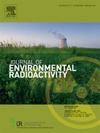Thermodynamic controls on plutonium(Pu) speciation in deep groundwater: Implications for HLW disposal safety at Beishan, China
IF 2.1
3区 环境科学与生态学
Q3 ENVIRONMENTAL SCIENCES
引用次数: 0
Abstract
The safe disposal of high-level radioactive wastes (HLWs) is a critical concern due to the environmental risks posed by radionuclides like plutonium (Pu), which is highly radiotoxic and has a long half-life. Deep geological disposal, such as at the Beishan site in Gansu Province, China, is considered a viable solution for isolating HLWs from the biosphere. However, the potential for tectonic disturbances and fracture networks raises concerns about the migration of radionuclides, making it essential to understand the speciation and mobility of Pu in deep groundwater. Previous studies have largely focused on surface environments, with limited attention to Pu behavior under deep geological conditions. This study employs thermodynamic simulations using PHREEQC to examine Pu speciation in deep groundwater of Beishan, evaluating the effects of pH, redox potential (pe), temperature, and ionic concentrations. Results demonstrate that Pu predominantly exists as Pu(OH)4 at neutral to alkaline pH, with significant changes in speciation under varying conditions. At acidic pH (2–2.5), Pu exists as a free ion in the +III oxidation state, while at higher pH (>7), Pu(OH)4 becomes dominant. Redox potential influences Pu speciation, with Pu(III) and Pu(IV) species forming at low and high pe values, respectively. Temperature influences the concentration of Pu(OH)4 but has a minimal effect on other species. Additionally, sulfate (SO42−) concentration significantly alters Pu speciation, while changes in bicarbonate (HCO3−), chloride (Cl−), and fluoride (F−) concentrations have minimal effects. The findings highlight the importance of considering local hydrogeochemical conditions in the design of HLW disposal facilities to optimize safety and minimize potential radionuclide migration.
深层地下水中钚(Pu)形态的热力学控制:对北山高浓缩铀处置安全的影响
由于钚(Pu)等放射性核素带来的环境风险,高放射性废物(HLWs)的安全处置是一个关键问题,钚(Pu)具有高放射性毒性且半衰期长。深层地质处置,如中国甘肃省北山场址,被认为是将高放射性物质与生物圈隔离的可行解决方案。然而,潜在的构造扰动和裂缝网络引起了人们对放射性核素迁移的关注,这使得了解深部地下水中Pu的形态和流动性变得至关重要。以往的研究主要集中在地表环境,对深部地质条件下的Pu行为关注较少。本研究利用PHREEQC进行热力学模拟,研究了北山深层地下水中Pu的形态,评价了pH、氧化还原电位(pe)、温度和离子浓度对Pu形态的影响。结果表明,在中性至碱性pH条件下,Pu主要以Pu(OH)4的形态存在,且在不同条件下形态变化显著。在酸性pH(2-2.5)下,Pu以+III氧化态的自由离子存在,而在较高pH (>7)下,Pu(OH)4成为优势离子。氧化还原电位影响Pu的形成,在低pe值和高pe值下分别形成Pu(III)和Pu(IV)。温度对Pu(OH)4的浓度有影响,但对其他物质的影响很小。此外,硫酸盐(SO42−)浓度显著改变了Pu的形态,而碳酸氢盐(HCO3−)、氯化物(Cl−)和氟化物(F−)浓度的变化影响最小。研究结果强调了在设计高放废物处置设施时考虑当地水文地球化学条件的重要性,以优化安全性并最大限度地减少潜在的放射性核素迁移。
本文章由计算机程序翻译,如有差异,请以英文原文为准。
求助全文
约1分钟内获得全文
求助全文
来源期刊

Journal of environmental radioactivity
环境科学-环境科学
CiteScore
4.70
自引率
13.00%
发文量
209
审稿时长
73 days
期刊介绍:
The Journal of Environmental Radioactivity provides a coherent international forum for publication of original research or review papers on any aspect of the occurrence of radioactivity in natural systems.
Relevant subject areas range from applications of environmental radionuclides as mechanistic or timescale tracers of natural processes to assessments of the radioecological or radiological effects of ambient radioactivity. Papers deal with naturally occurring nuclides or with those created and released by man through nuclear weapons manufacture and testing, energy production, fuel-cycle technology, etc. Reports on radioactivity in the oceans, sediments, rivers, lakes, groundwaters, soils, atmosphere and all divisions of the biosphere are welcomed, but these should not simply be of a monitoring nature unless the data are particularly innovative.
 求助内容:
求助内容: 应助结果提醒方式:
应助结果提醒方式:


